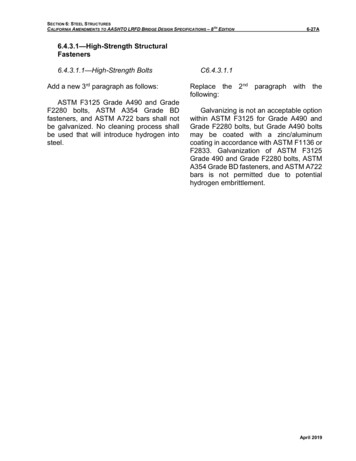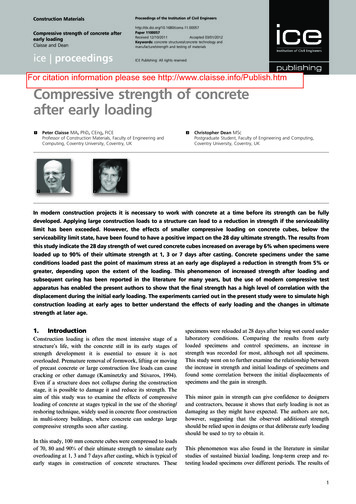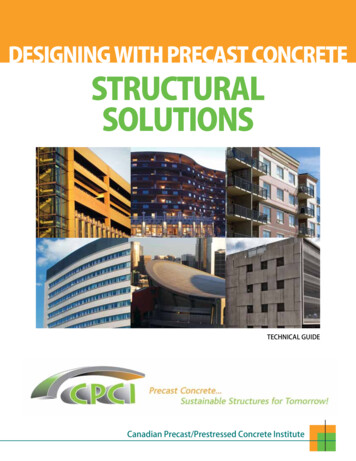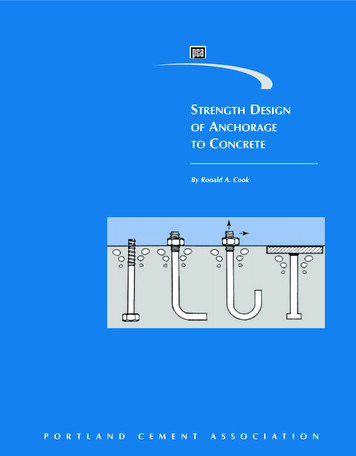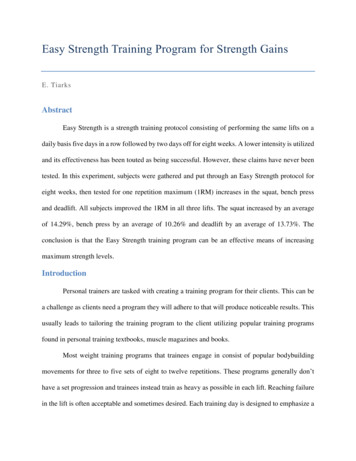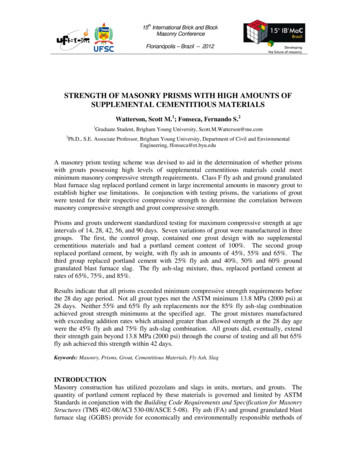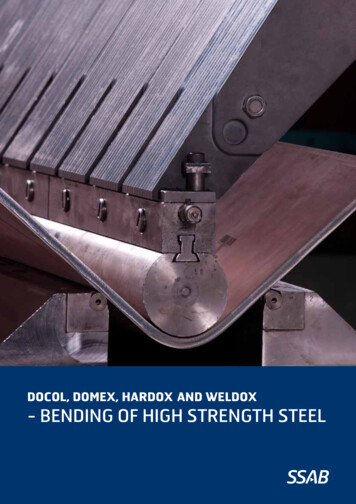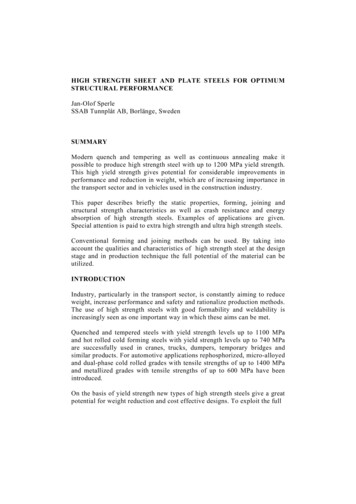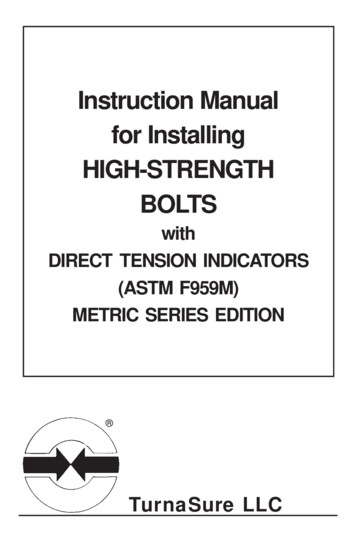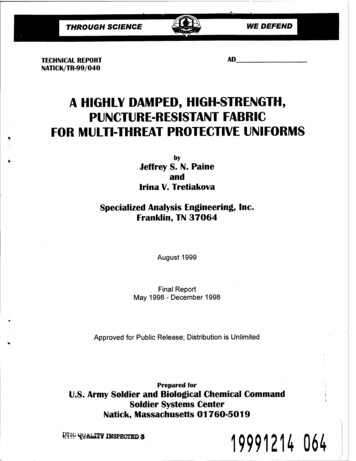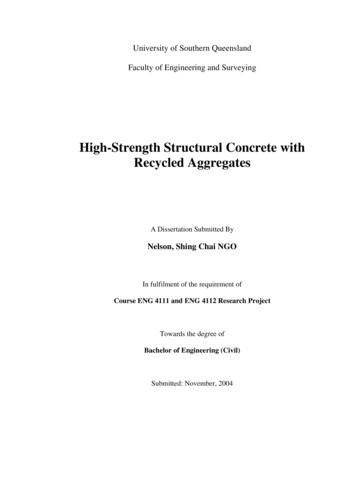
Transcription
University of Southern QueenslandFaculty of Engineering and SurveyingHigh-Strength Structural Concrete withRecycled AggregatesA Dissertation Submitted ByNelson, Shing Chai NGOIn fulfilment of the requirement ofCourse ENG 4111 and ENG 4112 Research ProjectTowards the degree ofBachelor of Engineering (Civil)Submitted: November, 2004
AbstractRecycled aggregates are comprised of crushed, graded inorganic particles processed fromthe materials that have been used in the constructions and demolition debris. The aim forthis on – going project is to determine the strength characteristic of recycled aggregatesfor application in high strength structural concrete, which will give a better understandingon the properties of concrete with recycled aggregates, as an alternative material to coarseaggregate in structural concrete. The scope of this project is to determine and compare thehigh strength concrete by using different percentage of recycled aggregates.The investigation was carried out using workability test, compressive test, indirect tensiletest and modulus of elasticity test. There were total of eight batches of concrete mixes,consists of every 20% increment of recycled aggregate replacement from 0% to 100%.Moreover, 100% of recycled aggregate mix batches included fly ash, water/cement ratioof 0.36 and 0.43. The workability of concrete considerably reduced as the amount ofrecycled aggregate increased. This was evaluated through standard slump test andcompacting factor test. For strength characteristics, the results showed that a graduallydecreasing in compressive strength, tensile strength and modulus of elasticity as thepercentage of recycled aggregate used in the specimens increased.
CertificationI certify that the ideas, designs and experimental work, results and analyses andconclusions set out in this dissertation are entirely my own effort, except where otherwiseindicated and acknowledged.I further certify that the work is original and has not been previously submitted forassessment in any other course or institution, except where specifically stated.NGO Shing Chai, NelsonStudent Number: D1230158SignatureDate
AcknowledgmentsFirstly, I would like to thank Dr. Thiru Aravinthan for his advice, support and assistancethroughout the duration of this project.I also want to thanks Mr. Glen Bartkowski, and Mr. Bernhard Black for their valuableassistance during the testing phase of the project.The help of my fellow students who are Mr. Ronald Wong Chuan Mein, Mr. Eric CheongFong Chin and Mr. Tagarajan Perumal is also greatly appreciated.Finally, to my family and friends, thanks for all the time, patience and undying supportprovided throughout the year.
Table of le of ContentvList of FiguresviiiList of TablesxAppendicesxiChapter 1Introduction1.1 Introduction of Recycled Aggregate1-11.2 Historical Background1-21.3 Applications of Recycled Aggregate1-31.4 International Status1-81.5 Advantages1-101.6 Disadvantages1-121.7 Project Aim1-131.8 Project Scope1-131.9 Dissertation Overview1-14Chapter 2Review of Recycled Aggregate2.1 Literature Review of Recycled Aggregate2-12.2 Review on Recycled Process2-42.2.1 Recycling Plant2-42.2.2 Sources of Recycled Aggregate2-42.2.3 Equipments used during Recycling Process2-52.2.3.1 Portland Cement Pavement2-52.2.3.2 Structural Building2-7v
2.2.4 Transportation2-92.2.5 Crushing Plant2-102.2.6 Screening Plant and Washing Plant2-132.2.7 Stockpile2-142.3 Comparison of Recycled Aggregate and Natural AggregateChapter 32-16Properties and Testing of Aggregate3.1 Particle Density and Water Absorption of Course and Fine Aggregate3-13.1.1 Apparatus and Test Procedure of Course Aggregate3-23.1.2 Apparatus and Test Procedure of Fine Aggregate3-33.1.3 Result and Analysis3-63.2 Sieve Analysis3-113.2.1 Apparatus and Test Procedure of Sieve Analysis3-123.2.2 Result and Analysis3-143.3 Mix Design3-153.4 Mixing of Concrete3-173.5 Placing, Compaction and Casting of Concrete Specimens3-193.6 Stripping and Curing of Concrete Specimens3-213.7 Summary3-22Chapter 4Experimental Methodology4.1 Introduction4-14.2 Workability Tests of Fresh Concrete4-14.2.1 Slump Test4-24.2.1.1 Apparatus and Test Procedure of Slump Test4.2.2 Compacting Factor Test4-34-64.2.2.1 Apparatus and Test Procedure of Compacting Factor Test 4-74.3 Testing on Hardened Concrete Specimens4.3.1 Compression Test4-104-11vi
4.3.1.1 Apparatus and Test Procedure of Compression Test4.3.2 Indirect Tensile Test4-134.3.2.1 Apparatus and Test Procedure of Indirect Tensile Test4.3.3 Modulus of ElasticitySummaryChapter 54-144-154.3.3.1 Apparatus and Test Procedure of Modulus of Elasticity4.44-114-164-18Tests Results and Analysis5.1 Introduction5-15.2 Slump Test Result and Analysis5-15.3 Compacting Factor Test Result and Analysis5-35.4 Compression Test Result and Analysis5-55.5 Indirect Tensile Test Result and Analysis5-115.6 Modulus of Elasticity Result and Analysis5-165.7 Summary5-19Chapter 6Conclusion and Recommendations6.1 Achievement of Objectives6-16.2 Conclusion6-26.3 Recommendations for Further Studies6-3Referencevii
List of FiguresFigure 1.1: Recycled Aggregate1-1Figure 1.2: Application of Recycled Aggregate as Road Kerb1-3Figure 1.3: Recycled Aggregate used as Granular Base Course1-4Figure 1.4: Typical Paving Blacks1-5Figure 1.5: Recycled Aggregate as Backfill Materials1-6Figure 1.6: Recycled Aggregate used as Building Blocks1-7Figure 1.7: Construction of the New High School in Sorumsand, Oslo, Norway1-8Figure 2.1: Diesel Pile – Driving Hammer2-5Figure 2.2: Rhino – horn – tooth – ripper – equipped Hydraulic Excavator2-6Figure 2.3: Hydraulic Crusher with Long Boon Arm2-7Figure 2.4: Wrecking Ball2-8Figure 2.5: Kingdome Implosion2-8Figure 2.6: Roll – off Container2-9Figure 2.7: Load into Primary Crusher2-10Figure 2.8: Electromagnetic Separation Process2-11Figure 2.9: Picking Shed2-12Figure 2.10: Wet Separation Process (Aquamator)2-12Figure 2.11: Screening Plant2-13Figure 2.12: Washing Plant2-14Figure 2.13: Stockpile2-14Figure 2.14: Load Out and Sales2-15Figure 2.15: Recycling Portland Cement Concrete Flow Chart2-15Figure 2.16: Comparison between Natural Aggregate and Recycled Aggregate2-16Figure 3.1: Balance for Aggregate Weighting3-5Figure 3.2: Thermostatically Controlled Oven3-6Figure 3.3: Sieve Machine for Course Aggregate3-13Figure 3.4: Sieve Machine for Fine Aggregate3-13Figure 3.5: Horizontal Pan Mixer3-18Figure 3.6: Cylinder Moulds for the Concrete Specimens3-20viii
Figure 3.7: Vibrator for Fresh Concrete Compaction3-20Figure 3.8: Curing Room for Concrete Specimens3-21Figure 4.1: The Apparatus for Slump Test4-4Figure 4.2: Typical Slump Test4-5Figure 4.3: The Apparatus for Compacting Factor Test4-6Figure 4.4: Standard Compacting Factor Apparatus4-8Figure 4.5: Setup of Compression Test4-13Figure 4.6: Setup of Indirect Tensile Test4-15Figure 4.7: Setup of Modulus of Elasticity4-17Figure 5.1: Graph showing the result of Slump Test5-2Figure 5.2: Graph showing the result of Compacting Factor Ratio5-4Figure 5.3: Variation of Compressive Strength with Age5-6Figure 5.4: Specimens after Testing5-7Figure 5.5: Graph shows the Percentage of Compressive Strength Remained5-8Figure 5.6: Graph shows the Percentage of Decreasing in Compressive Strength5-9Figure 5.7: Variation of Compressive Strength Gained with Time5-10Figure 5.8: Variation of Tensile Strength5-12Figure 5.9: Specimens after Testing5-13Figure 5.10: Graph shows the Percentage of Tensile Strength Remained5-14Figure 5.11: Graph shows the Percentage of Tensile Strength Dropped5-14Figure 5.12: Variation of Modulus of Elasticity5-17Figure 5.13: Stress and Strain Relationship5-18ix
List of TableTable 3.1: Weight of course aggregate in the test3-6Table 3.2: Weight of fine aggregate in the test3-9Table 3.3: Result of particle density and water absorption of all aggregate3-10Table 3.4: Percentage sieve size passing for all aggregate3-14Table 3.5: Percentage of aggregate used in all 8 batches of mixes3-16Table 3.6: Initial data for mix design3-16Table 3.7: Proportion and weight of each mix materials3-16Table 5.1: The slump result for each batch of mix concrete5-1Table 5.2: The compacting factor ratio for each of mix concrete5-3Table 5.3: Variation of compressive strength (MPa) with age5-5Table 5.4: Percentage of compressive strength remained and dropped5-8Table 5.5: Variation of tensile strength5-11Table 5.6: Percentage of tensile strength remained and dropped5-13Table 5.7: The results obtained from different percentage ofrecycled aggregate replacement5-16x
AppendicesAppendix A Project SpecificationAppendix B Reference Required for Properties and Testing of AggregateAppendix C Individual Compressive Strength ResultAppendix D Individual Percentage Compressive Strength Gain with TimeAppendix E Individual Test Results for Indirect Tensile StrengthAppendix F Individual Stress and Strain Relationshipxi
Chapter 1IntroductionCHAPTER 1INTRODUCTION1.1Introduction of Recycled AggregateRecycling is the act of processing the used material for use in creating new product. Theusage of natural aggregate is getting more and more intense with the advanceddevelopment in infrastructure area. In order to reduce the usage of natural aggregate,recycled aggregate can be used as the replacement materials. Recycled aggregate arecomprised of crushed, graded inorganic particles processed from the materials that havebeen used in the constructions and demolition debris. These materials are generally frombuildings, roads, bridges, and sometimes even from catastrophes, such as wars andearthquakes.Figure 1.1:Recycled Aggregate1-1
Chapter 11.2IntroductionHistorical BackgroundThe applications of recycled aggregate in the construction areas are wide and they hadbeen used long time ago.Wilmot and Vorobieff (1997) stated that recycled aggregate have been used in the roadindustry for the last 100 years in Australia. They also stated that the use of recycledaggregate for the construction and rehabilitation of local government roads has a greatimprove in the last five years.C & D Recycling Industry (n.d.), the fact file stated that from the time of the Romans, thestones from the previous roads were reused when rebuilding their vaunted set of roads. Italso stated that since the end of world war two, the recycling industry had been wellestablished in Europe.According to Seecharan (2004), the Detroid News stated that in 1980s, the old concretecrushed into a powder was a popular road builder at Michigan, USA.1-2
Chapter 11.3IntroductionApplications of Recycled AggregateTraditionally, the application of recycled aggregate is used as landfill. Nowadays, theapplications of recycled aggregate in construction areas are wide. The applications aredifferent from country to country. Concrete Kerb and Gutter MixRecycled aggregate have been used as concrete kerb and gutter mix in Australia.According to Building Innovation & Construction Technology (1999), Stone says that the10mm recycled aggregate and blended recycled sand are used for concrete kerb andgutter mix in the Lenthall Street project in Sdyney.Figure 1.2:Application of Recycled Aggregate as Road Kerb(Source: Building Innovation & Construction Technology, 1999)1-3
Chapter 1 IntroductionGranular Base Course MaterialsAccording to Market Development Study for Recycled Aggregate Products (2001),recycled aggregate are used as granular base course in the road construction. It also statedthat recycled aggregate had proved that better than natural aggregate when used asgranular base course in roads construction. They also found that when the road is built onthe wet sub grade areas, recycled aggregate will stabilize the base and provide animproved working surface for pavement structure construction.Figure 1.3:Recycled Aggregate used as Granular Base Course(Source: Mehus and Lillestol (n.d))1-4
Chapter 1 IntroductionEmbankment Fill MaterialsMarket Development Study for Recycled Aggregate Products (2001) stated that recycledaggregate can be used in embankment fill. The reason for being able to use inembankment fill is same as it is used in granular base course construction. Theembankment site is on the wet sub grade areas. Recycled aggregate can stabilize the baseand provide an improved working surface for the remaining works. Paving BlocksRecycled aggregate have been used as paving blocks in Hong Kong. According to HongKong Housing Department (n.d.), recycled aggregate are used as typical paving blocks. Atrial project had been started to test the long – term performance of paving blocks madewith recycled aggregate in 2002.Figure 1.4:Typical Paving Blocks(Source: Hong Kong Housing Department, (n.d.))1-5
Chapter 1 IntroductionBackfill MaterialsRecycled aggregate can be used as backfill materials. Mehus and Lillestol (n.d) foundthat Norwegian Building Research Institute (n.d) mentioned that recycled concreteaggregate can be used as backfill materials in the pipe zone along trenches after havingtesting in laboratory.Figure 1.5:Recycled Aggregate as Backfill Materials(Source: Mehus and Lillestol (n.d))1-6
Chapter 1 IntroductionBuilding BlocksRecycled aggregate used as building blocks. Mehus and Lillestol (n.d) stated that OptirocAS had used recycled aggregate to produce the masonry sound insulation blocks. Themasonry sound insulation blocks that produced had met all the requirements during thelaboratory testing.Figure 1.6:Recycled Aggregate used as Building Blocks(Source: Mehus and Lillestol (n.d))1-7
Chapter 11.4IntroductionInternational StatusMehus and Lillestol (n.d.) stated that RESIBA had constructed a new high school inSorumsand, outside the city of Oslo, Norway in 2001. Recycled concrete aggregate hadbeen used in this project. Thirty – five percent of coarse aggregate were replaced byrecycled concrete aggregate in the foundations, half of the basement walls and columns.Several tests were conducted
From the obtained result, most of the natural aggregate and recycled aggregate passed through 19mm sieve size, but less than 1% of aggregate passed through 1.18mm sieve size. Almost all the recycled aggregate passed through 13.20mm sieve size, but only 80% of natural aggregate passed through 13.20mm sieve size.
